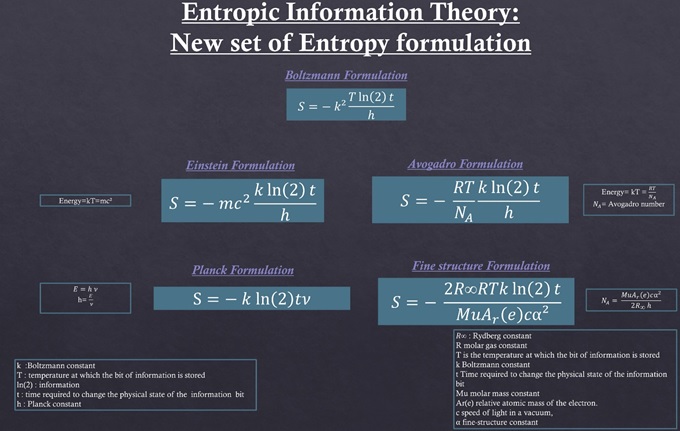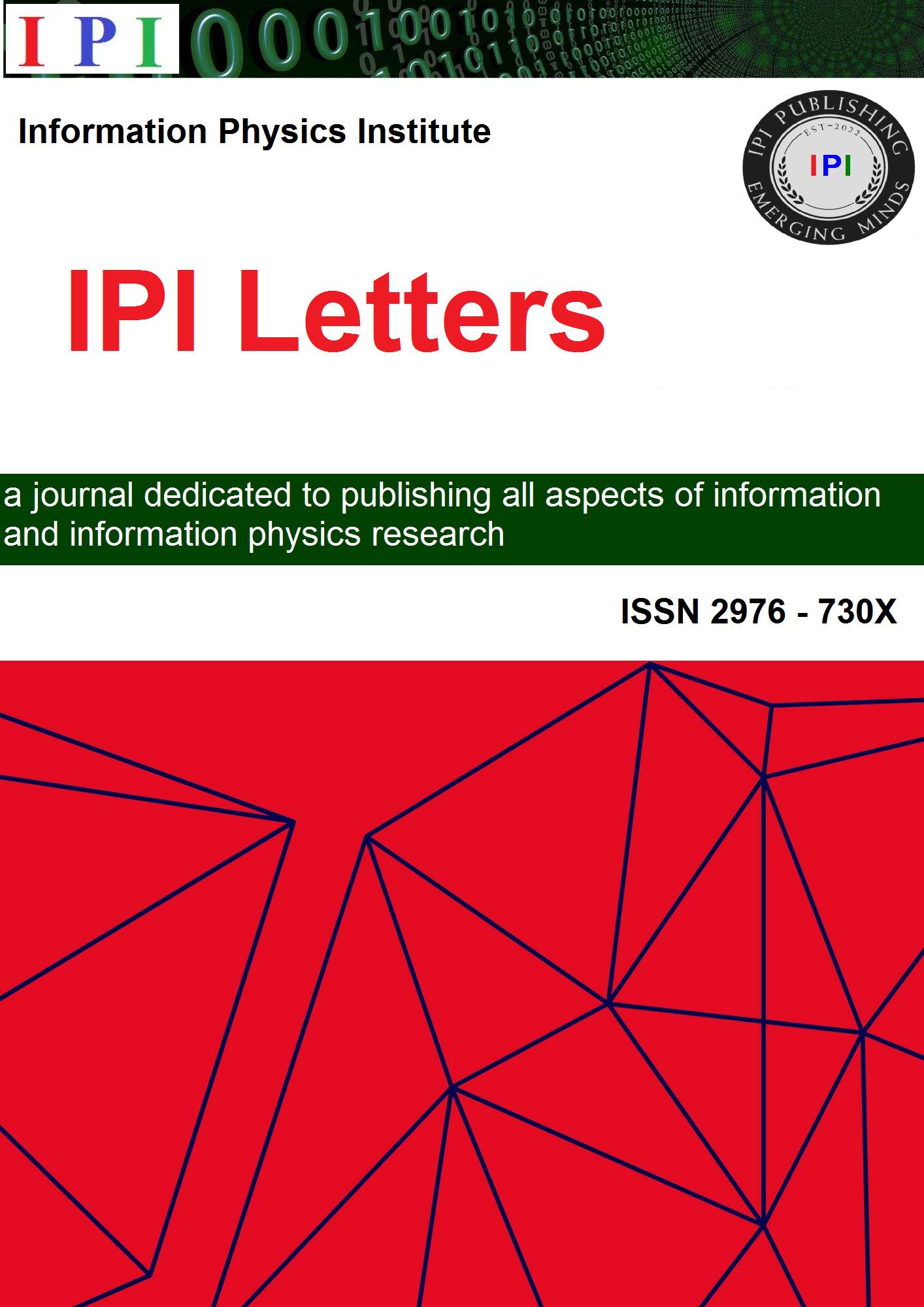Informational Nature of Dark Matter and Dark Energy and the Cosmological Constant
DOI:
https://doi.org/10.59973/ipil.36Keywords:
Dark matter, Dark energy, Cosmological constant, Vacuum energy, Landauer's principle, InformationAbstract
In this article, realistic quantitative estimation of dark matter and dark energy considered as informational phenomena have been computed, thereby explaining certain anomalies and effects within the universe. Moreover, by the same conceptual approach, the cosmological constant problem has been reduced by almost 120 orders of magnitude in the prediction of the vacuum energy from a quantum point of view. We argue that dark matter is an informational field with finite and quantifiable negative mass, distinct from the conventional fields of matter of quantum field theory and associated with the number of bits of information in the observable universe, while dark energy is negative energy, calculated as the energy associated with dark matter. Since dark energy is vacuum energy, it emerges from dark matter as a collective potential of all particles with their individual zero-point energy via Landauer's principle.
References
Gough, M.P. Information Equation of State. Entropy 2008, 10, 150-159. https://doi.org/10.3390/entropy-e10030150 DOI: https://doi.org/10.3390/entropy-e10030150
Vopson MM. The mass-energy-information equivalence principle. AIP Adv. 2019;9(9):095206. DOI:https://doi.org/10.1063/1.5123794. DOI: https://doi.org/10.1063/1.5123794
Vopson MM. Experimental protocol for testing the mass–energy–information equivalence principle. AIP Advances 1 March 2022; 12 (3): 035311. https://doi.org/10.1063/5.0087175 DOI: https://doi.org/10.1063/5.0087175
Denis, O. (2023). The entropy of the entangled Hawking radiation. IPI Letters, 1, 1–17.https:/doi.org/10.59973/ipil.9 DOI: https://doi.org/10.59973/ipil.9
Landauer, R. (1961) Irreversibility and Heat Generation in the Computing Process. IBM Journal of Research and Development, 5, 183-191.
http://dx.doi.org/10.1147/rd.53.0183 DOI: https://doi.org/10.1147/rd.53.0183
M.P. Gough, Holographic Dark Information Energy. Entropy 2011, 13, 924-935. https://doi.org/10.3390/e13040924 DOI: https://doi.org/10.3390/e13040924
Kragh H. Preludes to dark energy: zero-point energy and vacuum speculations". Archive for History of Exact Sciences. 2012;66(3):199–240. arXiv: https://arxiv.org/abs/1111.4623 DOI: https://link.springer.com/article/10.1007/s00407-011-0092-3. DOI: https://doi.org/10.1007/s00407-011-0092-3
Gough, M.P. Information Dark Energy Can Resolve the Hubble Tension and Is Falsifiable by Experiment. Entropy 2022, 24, 385. https://doi.org/10.3390/e24030385 DOI: https://doi.org/10.3390/e24030385
Gasparini, A. Testable Theory Suggests Information Has Mass and could Account for Universe’s Dark Matter. Scilight. 2019. DOI: https://doi.org/10.1063/1.5126530
Available online: https://aip.scitation.org/doi/10.1063/1.5126530 (accessed on 11 November 2022).
Jacob D Bekenstein. Black holes and entropy, Phys. Rev. D 7, 2333 – Published 15 April 1973 An article within the collection: 2015 - General Relativity’s Centennial and the Physical Review D 50th Anniversary Milestones; 2019 DOI: https://doi.org/10.1103/PhysRevD.7.2333
Hawking SW. Particle creation by black holes. Commun Math Phys. 1975; 43(3):199-220.DOI: 10.1007/BF02345020 DOI: https://doi.org/10.1007/BF02345020
Davies PCW. Why is the physical world so comprehensible? In: Zurek WH, editor.Complexity, entropy and the physics of information. Redwood City, CA: Addison-Wesley. 1990;61
Wheeler JA. Information, physics, quantum: the search for links’ at reproduced from. Proceedings of the 3rd international symposium. Tokyo: Foundations of Quantum Mechanics. 1989;354-68
Lloyd S. Computational capacity of the universe. Phys Rev Lett. 2002;88(23):237901.DOI: https://doi.org/10.1103/PhysRevLett.88.237901. DOI: https://doi.org/10.1103/PhysRevLett.88.237901
L. de Broglie, “Thermodynamics of Isolated Particle (Hidden Thermodynamics of Particles),” Gauthier-Villars, Paris, 1964
Erwin Schrödinger (1944), What Is Life? and Other Scientific Essays. Based on lectures delivered under the auspices of the Dublin Institute for Advanced Studies at Trinity College, Dublin, in February 1943. Doubleday (1956) and Internet Archive.
Ade PAR, et al. Planck 2013 results. XVI. Cosmological Parameters Astron Astrophys. 2014;571:A16
Vopson MM; The information catastrophe. AIP Advances 1 August 2020; 10 (8): 085014. https://doi.org/10.1063/5.0019941 DOI: https://doi.org/10.1063/5.0019941
Vopson MM; Estimation of the information contained in the visible matter of the universe. AIP Advances 1 October 2021; 11 (10): 105317. https://doi.org/10.1063/5.0064475 DOI: https://doi.org/10.1063/5.0064475
Tipler, F. J. (2005). "The structure of the world from pure numbers" (PDF). Reports on Progress in Physics. 68 (4): 897–964. arXiv:0704.3276. doi: https://doi.org/10.1088/0034-4885/68/4/R04 DOI: https://doi.org/10.1088/0034-4885/68/4/R04
Dirac, P. A. M. (1928). "The Quantum Theory of the Electron". Proceedings of the Royal Society A: Mathematical, Physical and Engineering Sciences. 117 (778): 610–624. Bibcode:1928RSPSA.117..610D. doi:10.1098/rspa.1928.0023. DOI: https://doi.org/10.1098/rspa.1928.0023
Braunstein SL, Pati AK. Quantum information cannot be completely hidden in correlations: Implications for the black-hole information paradox.
Daffertshofer A, Plastino AR. Landauer’s, principle and the conservation of information. Phys Lett A. 2005;342(3):213-6, DOI: https://doi.org/10.1016/j.physleta.2005.05.058. DOI: https://doi.org/10.1016/j.physleta.2005.05.058
Lee J-W, Lee J, Kim HC. Quantum informational dark energy: Dark energy from forgetting. arXiv E-Print, 2008;8. arXiv: https://doi.org/10.48550/arXiv.0709.0047
Bérut. [ journal Nature on March 8, 2012 Bérut A, Arakelyan A, Petrosyan A, Ciliberto S, Dillenschneider R, Lutz E., Experimental verification of Landauer’s principle linking information and thermodynamics, Nature. 2012 Mar 7;483(7388):187-9. doi: 10.1038/nature10872.] DOI: https://doi.org/10.1038/nature10872
Peebles PJE. Principles of physical cosmology. Princeton University Press;1993.
Casini H. Relative entropy and the Bekenstein bound. Class Quantum Grav. 2008;25(20):205021. DOI: 10.1088/0264-9381/25/20/205021. arXiv:0804.2182 DOI: https://doi.org/10.1088/0264-9381/25/20/205021
Bousso, Raphael (1999). "Holography in general space-times". Journal of High Energy Physics. 1999 (6): 028. arXiv:hep-th/9906022. Bibcode:1999JHEP...06..028B. doi:10.1088/1126-6708/1999/06/028. S2CID 119518763. DOI: https://doi.org/10.1088/1126-6708/1999/06/028
Bousso, Raphael (1999). "A covariant entropy conjecture". Journal of High Energy Physics. 1999 (7): 004. arXiv:hep-th/9905177. Bibcode:1999JHEP...07..004B. doi:10.1088/1126-6708/1999/07/004. S2CID 9545752. DOI: https://doi.org/10.1088/1126-6708/1999/07/004
Bousso, Raphael (2000). "The holographic principle for general backgrounds". Classical and Quantum Gravity. 17 (5): 997–1005. arXiv:hep-th/9911002. Bibcode:2000CQGra..17..997B. doi:10.1088/0264-9381/17/5/309. S2CID 14741276. DOI: https://doi.org/10.1088/0264-9381/17/5/309
Bekenstein, Jacob D. (2000). "Holographic bound from second law of thermodynamics". Physics Letters B. 481 (2–4): 339–345. arXiv:hep-th/0003058. Bibcode:2000PhLB..481..339B. doi:10.1016/S0370-2693(00)00450-0. S2CID 119427264. DOI: https://doi.org/10.1016/S0370-2693(00)00450-0
Bousso, Raphael (2002). "The holographic principle" (PDF). Reviews of Modern Physics. 74 (3): 825–874. arXiv:hep-th/0203101. Bibcode:2002RvMP...74..825B. doi:10.1103/RevModPhys.74.825. S2CID 55096624. Archived from the original (PDF) on 2011-08-12. Retrieved 2010-05-23. DOI: https://doi.org/10.1103/RevModPhys.74.825
Jacob D. Bekenstein, "Information in the Holographic Universe: Theoretical results about black holes suggest that the universe could be like a gigantic hologram", Scientific American, Vol. 289, No. 2 (August 2003), pp. 58-65. Mirror link. DOI: https://doi.org/10.1038/scientificamerican0803-58
Bousso, Raphael; Flanagan, Éanna É.; Marolf, Donald (2003). "Simple sufficient conditions for the generalized covariant entropy bound". Physical Review D. 68 (6): 064001. arXiv:hep-th/0305149. Bibcode:2003PhRvD..68f4001B. doi:10.1103/PhysRevD.68.064001. S2CID 119049155. DOI: https://doi.org/10.1103/PhysRevD.68.064001
Bekenstein, Jacob D. (2004). "Black holes and information theory". Contemporary Physics. 45 (1): 31–43. arXiv:quant-ph/0311049. Bibcode:2004ConPh..45...31B. doi:10.1080/00107510310001632523. S2CID 118970250. DOI: https://doi.org/10.1080/00107510310001632523
Everett, Allen; Roman, Thomas (2012). Time Travel and Warp Drives. University of Chicago Press. p. 167. ISBN 978-0-226-22498-5.
el-Hani, Charbel Nino, and Antonio Marcos Pereira (2000), « Higher-level Descriptions: Why Should We Preserve Them? », in Peter Bøgh Andersen, Claus Emmeche, Niels Ole Finnemann, and Peder Voetmann Christiansen (eds.), Downward Causation: Minds, Bodies and Matter, Aarhus (Danemark), Aarhus University Press
Albert Einstein, "Comment on Schrödinger's Note 'On a System of Solutions for the Generally Covariant Gravitational Field Equations'" https://einsteinpapers.press.princeton.edu/vol7-trans/47
O'Raifeartaigh C., O'Keeffe M., Nahm W. and S. Mitton. (2017). 'Einstein's 1917 Static Model of the Universe: A Centennial Review'. Eur. Phys. J. (H) 42: 431–474 DOI: https://doi.org/10.1140/epjh/e2017-80002-5

Downloads
Published
How to Cite
Issue
Section
License
Copyright (c) 2023 olivier denis

This work is licensed under a Creative Commons Attribution 4.0 International License.














